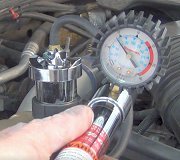First of all, without a thermostat it is very likely to overheat because the coolant doesn't stay in the radiator long enough to give up its heat. You will never solve a problem by removing a part, most of all the thermostat.
Next, it is perfectly normal for cooling systems to reach 220 degrees. That's eight degrees above the boiling point for water. That shouldn't occur real quickly but it might with driving at highway speed. Even driving at lower speeds can produce those really high temperatures when you don't have much natural air flow through the radiator. The radiator cap puts the system under pressure when the coolant gets hot. For every pound of pressure, the boiling point of the water increases three degrees. That means the boiling point increases 45 degrees to 257 degrees with a 15 pound radiator cap. You can expect the water to boil out of the coolant if you leave the radiator cap off.
Given the age of the car, and especially if you live up north where we throw a ton of salt on an ounce of snow, look at the cooling fins of the radiator to see if they're rotted away or crumble easily. That will prevent the radiator from dissipating the heat from the coolant. You can get a clue by the temperature coming down noticeably when you run the heater on full hot and the fan on the highest speed.
If you have bubbles going into the reservoir while the engine is running, (and the radiator cap is in place), suspect a leaking head gasket. Most mechanics have a chemical tester for that. You can also borrow or rent them from an auto parts store that borrows tools but you have to by the special liquid. Having a mechanic do the test might cost less than buying a whole bottle of the fluid.
SPONSORED LINKS
Sunday, April 1st, 2012 AT 8:00 AM



